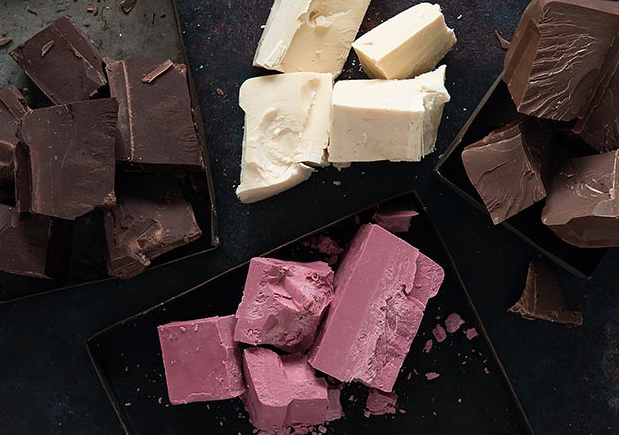By: Heidi Wagenbach
So I was searching for inspiration while writing Valentine’s Day themed blogs, when I came across an article about ruby chocolate that caught my eye. I had never heard it, and well, that’s because it’s relatively new and sold in only a few countries so far. Below is a short history and basic facts about this rose-colored, elusive sweet.
Brief History and Production
Following the iconic dark, milk, and white, ruby chocolate has been deemed “the fourth chocolate.” A Belgian chocolate manufacturer, Barry Callebaut Group, introduced this chocolate in late 2017. They claim it comes from a ruby cocoa bean, grown in Ecuador and Brazil, however that’s nothing new.
“They come from the same species of cacao plant that [makes] the chocolate we already know,” said The New York Times.
What gives this chocolate its different color is a particular mix of compounds, and Callebaut argues there are no added colors or flavors. The bright fuchsia that ruby chocolate has is explained through high levels of pigmented polyphenols and is enunciated through Callebaut’s minimal processing technique. They reduce fermentation and treat the product with citric acid, while using petroleum to remove fatty acids and preserve color. (For those of you who are curious for the exact definition, petroleum is: “a liquid mixture of hydrocarbons that is present in certain rock strata and can be extracted and refined to produce fuels including gasoline, kerosene, and diesel oil”). I don’t know about you, but I don’t think I’d be willing to try something that contains petroleum just to retain a pretty color.
More On Callebaut
The Barry Callebaut Group did not provide a lot of information about ruby chocolate on their website, simply calling it “a true gift from nature.” A theory about ruby chocolate is that this confectioner bred more cacao trees to grow fruits which naturally have more of a pink shade, seeing that 98% of cacao is a reddish-purple anyway when raw. Barry Callebaut Group states that only 36% of their cacao is sustainably sourced, so I’m not sure what you think, but ruby chocolate is sounding very similar to pink sea salt: more show and less usefulness.
Why Ruby Chocolate Faded Out Of Interest
It was advertised as “millennial chocolate” (gee, I wonder what age range they were targeting). Interest was lost over time, because the announcement, release, and availability did not correlate. Callebaut had 6-18 months to broker deals with chocolatiers, make more of this product, and build the hype, but in the end, people were wondering… what makes ruby chocolate so special?
Chocolate experts were skeptical yet anxious to taste the new, groundbreaking chocolate, but others were thinking it was a publicity stunt or faked. And they were right to be hesitant: no news, no talk shows, and the articles people were browsing to find more information about ruby chocolate were simply repeated information. The release corresponded with Valentine’s Day, and that was the holiday Callebaut was riding on. Once that passed, ruby chocolate failed to live up to its publicized oohs and ahhs. Experimentation has yet to take place, professionals asking whether it can be caramelized like its other chocolatey cousins, or if adding different ingredients can balance the sour flavors that for some people (depending on their taste-buds) is not pleasant.
Health Benefits (And Is It Even A Chocolate?)
Ruby chocolate is technically not a chocolate, according to the FDA. Their reasoning is that it contains the necessary ingredients to match chocolate (i.e. cocoa butter, sugar, milk powder, unsweetened chocolate), but are not the right percentages. There is too much unsweetened chocolate to be white, and not enough to be milk. As for dark, well it’s not dark chocolate, by simply looking at its appearance and taste. So the FDA needs another classification to determine what category ruby chocolate fits in.
As for nutritional benefits… ruby chocolate contains stearic acid, which is a saturated fat that doesn’t raise cholesterol. It acts as an antioxidant and has natural compounds that contribute to overall health (but I think I’ll continue indulging other chocolates instead).
Flavor Profile
Ruby chocolate, as described by Barry Callebaut is: “Neither bitter, milky, or sweet. It’s a rather tension of fresh berry fruitiness and luscious smoothness.” There are also notes of sour, tart, and tang. “Ruby chocolate is quite sweet and tastes like raspberry-flavored white chocolate with some milk chocolate added,” countered Isabell Maples, dietitian and nutritionist (Academy of Nutrition and Dietetics). Ruby chocolate has varying taste depending on the ratios of each ingredient in the recipes the companies use. Below is a diagram from Callebaut’s website showing the different qualities of ruby chocolate.

Where Can You Buy It?
In the U.S., Trader Joe’s had it for a limited time, in the form of crunchy wafers and pretzel-coated-goodies. So far, KitKat Ruby is the most popular interpretation of ruby chocolate, but is only available in Japan, South Korea, and the United Kingdom. (Don’t worry, if you’re that determined to get your hands on some, Amazon still has its wide variety of products to choose from). Ruby chocolate is a bit pricier, and is not organic nor vegan, but is vegetarian.
Conclusion
With Valentine’s Day right around the corner, I’d advise to just maybe skip the ruby chocolate and go with another candy assortment. (Or even better, a nice meal and movie night). I don’t want to bash this product, seeing that I haven’t tried it myself, but based on its background, ruby chocolate isn’t one that I’d bother tasting with its weird, unknown origin and mysterious company.
Sources:
Ruby – A True Gift From Nature
Here’s Why Everyone Is Talking About Ruby Chocolate
What Is Ruby Chocolate? How It’s Made, Ruby Cocoa, & FAQ

